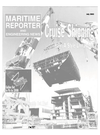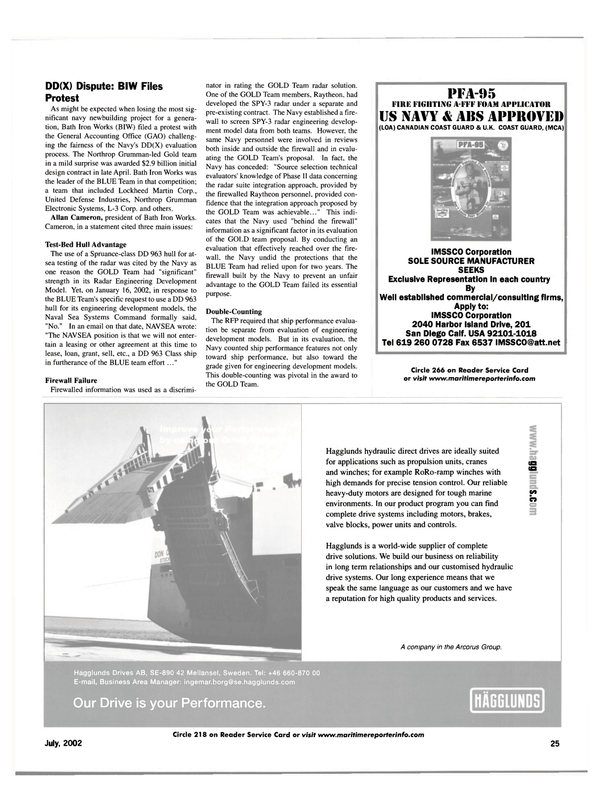
DD(X) Dispute: BIW Files Protest
As might be expected when losing the most significant navy newbuilding project for a generation, Bath Iron Works (BIW) filed a protest with the General Accounting Office (GAO) challenging the fairness of the Navy's DD(X) evaluation process. The Northrop Grumman-led Gold team in a mild surprise was awarded $2.9 billion initial design contract in late April. Bath Iron Works was the leader of the BLUE Team in that competition; a team that included Lockheed Martin Corp., United Defense Industries, Northrop Grumman Electronic Systems, L-3 Corp. and others.
Allan Cameron, president of Bath Iron Works.
Cameron, in a statement cited three main issues: Test-Bed Hull Advantage The use of a Spruance-class DD 963 hull for atsea testing of the radar was cited by the Navy as one reason the GOLD Team had "significant" strength in its Radar Engineering Development Model. Yet, on January 16, 2002, in response to the BLUE Team's specific request to use a DD 963 hull for its engineering development models, the Naval Sea Systems Command formally said, "No." In an email on that date, NAVSEA wrote: "The NAVSEA position is that we will not entertain a leasing or other agreement at this time to lease, loan, grant, sell, etc., a DD 963 Class ship in furtherance of the BLUE team effort ..." Firewall Failure Firewalled information was used as a discriminator in rating the GOLD Team radar solution.
One of the GOLD Team members, Raytheon, had developed the SPY-3 radar under a separate and pre-existing contract. The Navy established a firewall to screen SPY-3 radar engineering development model data from both teams. However, the same Navy personnel were involved in reviews both inside and outside the firewall and in evaluating the GOLD Team's proposal. In fact, the Navy has conceded: "Source selection technical evaluators' knowledge of Phase II data concerning the radar suite integration approach, provided by the firewalled Raytheon personnel, provided confidence that the integration approach proposed by the GOLD Team was achievable..." This indicates that the Navy used "behind the firewall" information as a significant factor in its evaluation of the GOLD team proposal. By conducting an evaluation that effectively reached over the firewall.
the Navy undid the protections that the BLUE Team had relied upon for two years. The firewall built by the Navy to prevent an unfair advantage to the GOLD Team failed its essential purpose.
Double-Counting The RFP required that ship performance evaluation be separate from evaluation of engineering development models. But in its evaluation, the Navy counted ship performance features not only toward ship performance, but also toward the grade given for engineering development models.
This double-counting was pivotal in the award to the GOLD Team.
Read DD(X) Dispute: BIW Files Protest in Pdf, Flash or Html5 edition of July 2002 Maritime Reporter
Other stories from July 2002 issue
Content
- Zodiac Debuts Bulletproof System For CRRC page: 5
- Historic $17 Billion Order Placed page: 6
- USCG Proposes New Changes in Vessel Arrival/Departure Procedures page: 9
- NASSCO Celebrates Keel Laying of Trailerships page: 11
- Industry-Wide Interoperability Investment Paying Off page: 12
- Tribon M2 Aim: Better Ships at a Lower Cost page: 14
- Total CAD/CAM Solution for Ship Design and Building page: 15
- Juniper Industries Keeps the Water Out page: 17
- Molding the five-deck Trailership page: 18
- IZAR Gijon Delivers Dredger page: 19
- Estonians Raise the Ferry Stakes page: 19
- Transportation Secretary Announces $92.3M in Port Security Grants page: 21
- USS Shoup Commissioned page: 23
- U.K. Royal Navy Increases Overhaul Efficiency of HP Air Cylinders page: 24
- DD(X) Dispute: BIW Files Protest page: 25
- Technological Wonder, No Matter How You SLICE It page: 26
- GALILEO: 2008 or Bust? page: 28
- Forget the Dog, MTN Delivers the News Onboard Residensea page: 29
- SeaWave Aims to Drive Down Communication Costs page: 29
- Iridium Aggressively Pursues New Outlets page: 30
- Fincantieri Stays Strong page: 32
- Fincantieri Predicts Clear Vista For HAL page: 32
- Rodriquez Cantieri Navali: Fast Company page: 33
- SEA RIDER Infiltrates Small Craft Propulsion Market page: 34
- ACG Makes Solid Inroads page: 35
- SubSea Solutions Alliance Provides Quick Fix - Underwater page: 36
- Classic Vessel's Demise Lead to New Found Hobby page: 38
- STAR Center Provides 360-Degree Field of View page: 41
- MAN B&W 48/60B Engine page: 42
- Titan Pulls One Off for Marine Response Alliance page: 54


